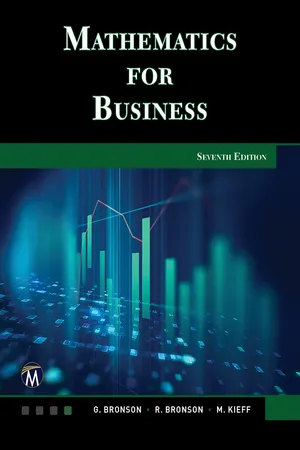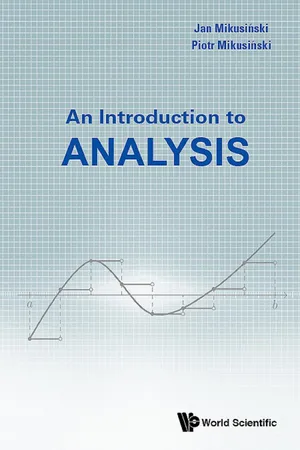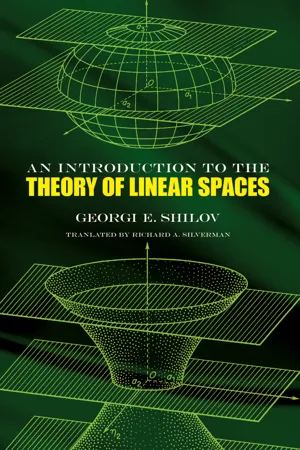Mathematics
Linear Functions
Linear functions are mathematical relationships between two variables that can be represented by a straight line on a graph. They have a constant rate of change, meaning that as one variable increases by a certain amount, the other variable changes by a consistent amount. The general form of a linear function is y = mx + b, where m is the slope and b is the y-intercept.
Written by Perlego with AI-assistance
Related key terms
6 Key excerpts on "Linear Functions"
- eBook - ePub
- Cinzia Bisi, Rita Fioresi(Authors)
- 2024(Publication Date)
- Chapman and Hall/CRC(Publisher)
.1.2 Linear Functions
We now examine the Linear Functions, which are of fundamental importance, since we can effectively approximate most physical or biological systems using Linear Functions.Definition 1.2.1 A function f : D → ℝ is linear, if f(x) = mx + c for suitable coefficients m ≠ 0, c in ℝ.We immediately see that both the domain and the image of a linear function coincide with the real numbers.The graph of a linear function is a line in the Cartesian plane and it is described by the equation y = mx + c. The number m is called the slope and, as we shall see, is of great importance.We have that:- If m = 0, the line is horizontal.
- The term c gives information about the points where the line intersects the Cartesian axes. In fact, if we substitute y = 0 in the equation of the line y = mx + c, we get the point of intersection of the line with the x-axis. Similarly, if we set x = 0, we get the point of intersection with the y-axis. These points are( −and (0,c)respectively.c m, 0 )
Let us now see the geometric meaning of the slope m. Let us consider a linear function f(x) = mx + c and the line described by its graph y = mx + c.Consider the two points on the line: P = (x1 , y1 ), with f(x1 ) = y1 and Q = (x2 , y2 ), with f(x2 ) = y2 . So, we have:f (x 1) = mx 1+ c , f (x 2) = mx 2+ cWe obtain the following expression for the slope m:f (x 2) − f (x 1) =y 2−y 1= m (x 2−x 1) , → m =y 2−y 1x 2−x 2in terms of the coordinates of P and Q.If α denotes the angle between the line and the x - eBook - ePub
Making Sense of Mathematics for Teaching High School
Understanding How to Use Functions
- Edward C. Nolan, Juli K. Dixon, Farhsid Safi, Erhan Selcuk Haciomeroglu(Authors)
- 2016(Publication Date)
- Solution Tree Press(Publisher)
In high school, students extend the work with linear equations and functions to construct functions between two quantities and model real-world situations. When presented with a linear relationship between quantities, students learn to construct an equation in two variables, compute the rate of change between the two variables, and interpret the rate of change in real-world situations. As they explore functional relationships verbally, numerically, graphically, and algebraically, they develop flexibility in translating among these different representations. They define and compare linear and nonlinear relationships, and this enables them to learn to distinguish among real-world situations regarding those that can be modeled with Linear Functions and those that cannot. Students in grade 8 become familiar with the concept of functions, and concepts such as domain, range, and the inverse of a function are introduced in high school coursework.The MathematicsEquations and functions can be used to model real-world situations and mathematical relationships. High school students must be able to analyze functions with multiple representations and connect the domain and range of a function to its graph. This is best accomplished by using a variety of situations so that students are able to establish meaningful connections among representations and consider reasons for the use of a particular representation.Analyzing Functions With Multiple RepresentationsConsider the task in figure 1.2 . Take a moment to make sense of this task before continuing.Figure 1.2: Perimeter of a rectangle.What equation did you create for the perimeter of the rectangle? Since the length is twice the width, if you use x for the width, the length would be 2x. How do you represent the perimeter of a rectangle? In this case, the perimeter can be represented as x + 2x + x + 2x = 2(x + 2x) = P. This can be simplified to be P = 2(3x) = 6x - eBook - ePub
- Gary Bronson, Richard Bronson, Maureen Kieff(Authors)
- 2021(Publication Date)
- Mercury Learning and Information(Publisher)
b , respectively, and the function is more typically written as:y = mx + b (m ≠ 0)(Eq. 3.5)This last equation is the slope-intercept form of a straight line that was presented in Section 2.3 . The graph of this equation is a straight line with slope m ; it intercepts the y -axis at the point (0, b ). Thus, the graph of a first-degree polynomial is a straight line with a non-zero slope. The graph of the line y = − 100x + 1500 is shown in Figure 3.9 . The line intercepts the y -axis at (0, 1500) and has a slope m = − 100.FIGURE 3.9 The graph of the first-degree polynomial y = − 100x + 1500.Functions whose graphs are nonvertical straight lines − the zero function, polynomials of degree zero, and polynomial functions of degree 1 − are all Linear Functions . By far, some of the most important business applications are modeled using linear equation, and were examined extensively in Chapter 2 .A vertical line, such as the one shown in Figure 3.10 , has an undefined slope and, as such, is not a linear function.Rational and Power FunctionsFIGURE 3.10 The vertical line x = 1.5.One class of function related to polynomial functions are rational functions . A rational function is one that is the quotient of two polynomials. It has the form:(Eq. 3.6)where p (x ) and q (x ) are both polynomial functionsExample 2 Determine which of the following functions are rational functions.a.b.c.d.Solutiona. This is a rational function. Here, the numerator is the 5th degree polynomial function , and the denominator is the 2nd degree polynomialb. This is a rational function because the numerator and denominator are polynomial functions of degrees 2 and 3, respectively.c. This is not a rational function. Although the denominator is a polynomial function of degree 1, the numerator is not a polynomial function due to the x 1/2 term, which raises x - eBook - ePub
- Paul Turner, Justine Wood(Authors)
- 2023(Publication Date)
- Mercury Learning and Information(Publisher)
x -axis than the original curve.FIGURE 2.3 Parabolas with parameters 1 (solid line) and 2 (broken line).REVIEW EXERCISES – SECTION 2.11. Calculate the equations of the straight lines passing through the following pairs of coordinates.(a)(b)(c)2. Given the following equations for straight lines, calculate the values of x, which give(a)(b)(c)3. Variables x and y both vary with time according to the formulas and . This defines a curve in the Cartesian plane. Find the alternative representation in the form of an equation which links y and x .2.2 FUNCTIONSA function is a rule which takes an element from one set and maps it to the elements of another set. Although functions are often written in the form of equations, they are not the same thing.A function is a rule which associates objects in one set with objects in another set. For example, a function could be a rule which takes one number (the argument or input ) and uses it to assign another number (the output or result ). Equations are often used to define the rule, but simply writing down an equation relating two variables is not sufficient to define a function. To fully define a function, we must also specify the sets of numbers which are valid inputs and outputs of the relationship we define. A simple example is an equation of the form . For this to be a function, we must also specify the set of numbers from which x is drawn and the set of numbers that comprises the possible outcomes, y . These are referred to as the domain and the codomain of the function. For example, we can define a function using the relationships shown in (2.1):. (2.1)The first part of the definition consists of the equation . This defines the rule which takes x, the argument of the function, and maps it to y , the output . The second part of this function defines the domain and the codomain. In this example, we say that the function f “maps” the set of integers to the set of integers. The notation can be read as “f maps the set of integers to itself.” Note that the same equation could be used to map the set of real numbers to itself, that is, - eBook - ePub
- Piotr Mikusi?????ski, Jan Mikusi?????ski;;;(Authors)
- 2017(Publication Date)
- WSPC(Publisher)
Chapter 2
LIMITS OF FUNCTIONS
2.1Functions
The concept of a function, arguably the most important concept in mathematics, is also a very important tool in describing phenomena of the surrounding world in which there is a dependence between entities. For instance, how does the distance traveled depend on the elapsed time? How does the pressure of a gas depend on its temperature? Such questions suggest that the concept of a function stems naturally from that of variable entities, called variables for short. However the concept of a variable is difficult to define accurately and all attempts to do so seem to obscure the concept of a function rather than clarify it. In some books a function is defined as a correspondence or a rule. But in fact such definitions only replace one word by another. The reader is assumed not to know what a function is but is supposed to know what a correspondence is. It seems that it would be better to say that everybody knows what a function is and therefore we do not have to define it. On the other hand we do not want to base a mathematical theory on such an assumption, because it would sooner or later cause some problems. There are important examples in the history of mathematics of such unfortunate cases.So what do we do if we want to have a precise definition of a function? The modern concept of a function is based on the concept of a relation, that is, a set of ordered pairs.A function f from a set X to a set Y is a collection of ordered pairs (x, y) such that(a)x ∈ X and y ∈ Y,(b)For every x ∈ X there exists a y ∈ Y such that (x, y) ∈ f,(c)If (x, y1 ) ∈ f and (x, y2 ) ∈ f, then y1 = y2 .S:Maybe the above formal definition of a function is a very rigorous one but it seems rather artificial. We often say that y = x2 or f(x) = x2 is a function. According to the above definition it is not, because f(x) = x2 is not a collection of ordered pairs.T:Strictly speaking this is true. On the other hand it is easy to see that the formula f(x) = x2 describes a collection of pairs: a pair (x, y) ∈ f if and only if y = f(x), that is, if and only if y = x2 . Using symbols, we can write f = {(x, x2 ) : x ∈ R - eBook - ePub
- Georgi E. Shilov, Richard A. Silverman(Authors)
- 2012(Publication Date)
- Dover Publications(Publisher)
4Linear Functions OF A VECTOR ARGUMENT
In courses on elementary mathematical analysis, one studies functions of one or more real variables. Such functions can be regarded as functions of a vector argument. For example, a function of three variables can be regarded as a function whose argument is a vector of the space V 3 . This suggests studying functions whose arguments are vectors from an arbitrary linear space. In making this study, we shall for the time being restrict ourselves to the simplest functions of this kind, namely linear functions. We shall first study linear numerical functions of a vector argument, i.e., functions whose values are numbers, and then linear vector functions of a vector argument, i.e., functions whose values are vectors (in fact, vectors from the same space as the space containing the argument). Linear vector functions, otherwise known as linear operators, are of great importance in linear algebra and its applications.25. Linear Forms
25.1. A numerical (or scalar) function f (x ) of the vector argument x , defined on a linear space R, is called a linear form if it satisfies the following conditions:- f (x + y ) = f (x ) + f (y ) for any x , y ∈ R ;
- f (αx ) = αf (x ) for any x ∈ R and any real number α.
By using induction, we can easily deduce from conditions 1 and 2 that if f (x ) is a linear form, thenf (α1 x 1 + α2 x 2 + ... + αk x k ) = α1 f (x 1 ) + α2 f (x 2 ) + ... + αk f (x k ),(1)for any x 1 , x 2 , ..., x k ∈ R and any real numbers α1, α2, . . . , αk .Example 1. Suppose a basis is chosen in an n-dimensional space R, so that every vector x ∈ R can be specified by its components ξ1, ξ2, ... ξn. Then f (x ) = ξ1 (the first component) is obviously a linear form in x.Example 2 . A more general linear form in the same space is the expressionwith arbitrary fixed coefficients c 1 , c 2 , . . . , c n .Example 3. An example of a linear form defined on the space C (a, b
Index pages curate the most relevant extracts from our library of academic textbooks. They’ve been created using an in-house natural language model (NLM), each adding context and meaning to key research topics.





